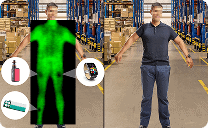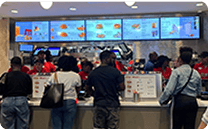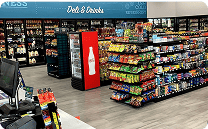In This article
The right tools can help operators protect themselves from embezzlement and save thousands of dollars.
Point-of-sale systems have become very sophisticated, and so has employee embezzlement. Contrary to the stereotype of the unhappy entry-level employee pocketing cash, it is often a manager who steals from an establishment by using high-tech methods. Operators who upgrade their technology and implement surveillance systems can protect themselves and save money.
“Managers have the ability to cover their tracks more than front-line employees,” says Donald Boyle, executive vice president of Operations for DTiQ, a full-service provider of loss prevention solutions for the hospitality and retail industries. “When managers steal, they embezzle for much larger amounts and it tends to go on for longer periods of time.”
In one case, a general manager at a quick-service restaurant was ringing up 15 manager meals each day. “We know there are not 15 managers working there in one day,” Boyle says. “He was applying a 100-percent manager discount, so he was creating an overage he could then take each day.”
At first, the general manager said he was giving the meals to vendors, high-performing workers, even bus drivers. He had been with this franchise location for 20 years and some family members worked at other locations owned by the same franchisee. Eventually, the now-former employee admitted to taking $8,000. “I think it is important to note that the next day the general manager’s wife and children quit their jobs,” Boyle says. “They were probably doing something similar.”
DTiQ found the discrepancy through SmartAudit™, its tool that collects data from POS, audio and video systems. The system leverages surveillance in a proactive way. Instead of watching hours of video footage to see if an employee does something dishonest, the system is triggered every time the back door opens, the POS system is used or the safe is opened. Loss prevention consultants review the reports and send email alerts to the operator.
“It’s mystery shopping on steroids,” Boyle says. Operators also use the system to make sure employees are keeping the place clean, are upselling when needed and using safe-food handling techniques. It can even see if workers, for example, are using their cell phone instead of performing a task.
Floating sales
Another method for an employee to embezzle money is through floating sales, which Boyle explains can happen when the restaurant has a popular, often-ordered menu item. A customer places the order and the worker begins to ring it up, then puts the transaction on hold as if the customer is still thinking about it, and receives the money from the customer. Then when another customer orders the same meal, the worker rings that up, puts it on hold and so on. “They may finalize it the third time,” Boyle says, but the money for only one sale goes into the register.
Of course, there are more traditional theft tactics, such as hitting the no sale key to open the drawer. DTiQ offers systems that can overlay the POS transactions with video so the operator can see what the cashier is doing.
In general, installing a surveillance or antitheft system can help operators save money. According to the Austin, Texas-based Association of Certified Fraud Examiners (ACFE), the typical organization loses 5 percent of revenues in a given year as a result of fraud. The ACFE, in its 2016 Global Fraud study, notes that the presence of anti-fraud controls was correlated with both lower fraud losses and quicker detection. In organizations that had anti-fraud controls in place, fraud losses were 14-percent to 54-percent lower and frauds were detected 33 percent to 50 percent more quickly than in organizations lacking those controls.
High risk operations
James “Rick” Youngblood, a certified fraud examiner and protection professional, says bars and quick-service restaurants are especially at risk for employee embezzlement. “Bars, for the amounts of cash changing hands, ability to create large amounts of wasted product, high customer traffic areas and the limited ability to monitor each transaction,” he says. “QSRs because many employ high-school-age associates, offer the ability for employees to cover money theft through waste creation and generate numerous cash transactions and high rates of employee turnover.”
High-school-age workers are especially likely to engage in “sweet-hearting,” or handing out free food to friends. They might then claim the food was thrown away. One way to prevent this, Youngblood says, is to know the establishment’s average weekly product waste numbers.
According to Richard Hollinger, criminology professor emeritus at the University of Florida in Gainesville, employees sometimes use food waste as a rationalization for stealing. “It’s the pre-trash factor,” he says. “In a fast-food restaurant the food degrades over a period of time so the person says, ‘It’s going to be thrown away anyway so why not give it to my friend or to me?’”
There is another tool that is more complex than surveillance and technology. “The real magic trick in reducing employee theft is allowing them to buy into the success of the organization,” Hollinger says. “If they feel like they are going to benefit with their hard work, the business wins and the employee wins.”
There is also prevention, which means not hiring people who are likely to steal. One tool is the background check. “You can’t have a risk management program without a background check program,” says Tim Landsberger, director, sales and marketing for The McDowell Agency, Inc., a private investigation firm in St. Paul, Minnesota.
Besides determining whether the potential employee has a criminal background, there are other benefits. Just as an employee will likely not embezzle if they know they are being monitored, a dishonest person will not apply for a job if they know their past will become known.
A past crime does not always disqualify the job applicant. Some employers use the background check to start a conversation. “If you decide you want to give someone an opportunity, it encourages them to be open and honest,” Landsberger says.
Communication itself can be a tool to prevent embezzlement. “It is so important for operators to know who their employees are,” says Boyle. “[They need to know] if things are going on such as family illnesses, whether they’re having financial difficulties, substance abuse problems, marital problems — this will cause people to make poor decisions.”
Remember that these tips aren’t foolproof – we’ve all made bad hires and have had to deal with the fallout. However, if you put in the extra effort to source applicants that are truly aligned with your expectations and personality requirements, you’ll become much closer to acquiring the candidate who best fits the organization.


























